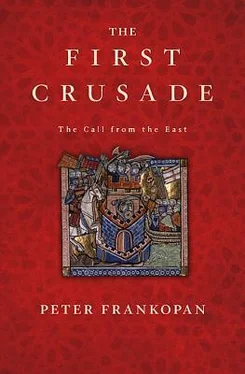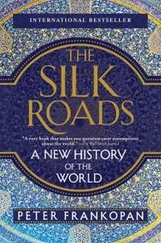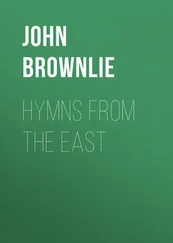1 Europe in Crisis
1. Gregory VII, Register , I.1, p. 1. • 2. Ibid., I.25, p. 30. • 3. See here U-R. Blumenthal, The Investiture Controversy: Church and Monarchy from the Ninth to the Twelfth Century (Philadelphia, 1988); G. Tellenbach, The Western Church from the Tenth to the Early Twelfth Century (Cambridge, 1993); H. Cowdrey, Pope Gregory VII, 1073–1085 (Oxford, 1998). • 4. Gregory VII, Register , III.6, p. 181; III.10a, pp. 192–3. • 5. Hugh of Flavigny, II, p. 458; Lampert, Annales , pp. 258, 264–5; Berthold, p. 284; Bonizo of Sutri, Liber , 8, p. 609. • 6. Gregory VII, Register , VII.14, pp. 342–4. • 7. Benzo of Alba, Ad Henricum , VI, Preface, p. 502. • 8. C. Erdmann (ed.), Die Briefe Heinrichs IV (Leipzig, 1937), 18, p. 28. • 9. P. Kehr, ‘Due documenti pontifici illustranti la storia di Roma negli ultimi anni del secolo XI’, Archivio della Società Romana di storia patria 23 (1900), pp. 277–83. • 10. Bernold of Constance, p. 508. • 11. Urban introduced the prospect of remission from sin for knights who went to fight in Spain, which was to have an important bearing on spiritual rewards available for would-be Crusaders. The Pope’s offer in Spain, however, had little impact on the knighthood of Europe as a whole. See J. von Pflugk-Hartung, Acta pontificum Romanorum inedita, 3 vols. (Leipzig, 1880–8), 2, pp. 142–3; Urban II, Epistolae et Privilegia , in Patrologia Latina 151, cols. 288, 302–3, 332–3. Also A. Becker, Papst Urban II , 2 vols. (Stuttgart, 1964–88), 1, pp. 246ff. • 12. F. Liebermann, ‘Lanfranc and the antipope’, English Historical Review 16 (1901), pp. 330–2. • 13. P. Kehr, ‘Papsturkunden in Rom: Erster Bericht’, Nachrichten von der Gesellschaft der Wissenschaften zu Göttingen, Phil-hist. Kl. (1900), pp. 148–9. • 14. Only the reply to Clement III’s messages survives. A. Pavlov, ‘Otryvki grecheskago teksta kanonicheskikh otvetov russkago mitropolita Ioanna II’, Zapiski Imperatorskoi Akademii Nauk , 22.5 (1873), pp. 169–86. • 15. Imperial heirs were often crowned co-emperor at or soon after birth – hence spaces for two names in the formula. De Cerimoniis aulae Byzantinae libri duo , ed. J. Reiske, 2 vols. (Bonn, 1829–30) , 48, vol. 2, pp. 686–92; 46, vol. 2, p. 679. • 16. C. Will, Acta et scripta quae de controversiis Ecclesiae Graecae et Latinae (Leipzig, 1861), pp. 150–4. • 17. J. Mansi (ed.), Sacrorum Concilium Amplissima Collectio , 31 vols. (Florence, 1759–98), 20, cols. 507–8; Gregory VII, Register , VI.5b, p. 281. Alexios’ excommunication is mentioned by Bernold of Constance, pp. 479–80. • 18. William of Apulia, IV, p. 230; cf. Anna Komnene, I.13, p. 40. • 19. The most reliable material here comes from the canons agreed at the council, six letters sent by the Pope to Flanders, Tuscany and Spain, and also contemporary accounts of sermons preached by Urban in France after Clermont, such as in Angers in February 1096. Somerville, Councils of Urban II , pp. 74, 124; Hagenmeyer, Epistulae , pp. 136, 137–8; W. Wiederhold, ‘Papsturkunden in Florenz’, Nachrichten von der Gesellschaft der Wissenschaften zu Göttingen, Phil-hist. Kl. (1901), pp. 313–14; P. Kehr, Papsturkunden in Spanien. I Katalonien (Berlin, 1926), pp. 287–8; L. Halphen and R. Poupardin, Chronique des comtes d’Anjou et des seigneurs d’Amboise (Paris, 1913), pp. 237–8. • 20. Geoffrey Malaterra, IV.13, p. 92; W. Holtzmann, ‘Die Unionsverhandlungen zwischen Kaiser Alexios I und Papst Urban II im Jahre 1089’, Byzantinische Zeitschrift , 28 (1928), pp. 60–2. • 21. Anna Komnene, V.9, p. 151. • 22. Holtzmann, ‘Unionsverhandlungen zwischen Kaiser Alexios I und Papst Urban II’, pp. 60–2. • 23. Ibid. • 24. Ibid., pp. 62–4. • 25. Theophylact of Ohrid, Peri egkalountai Latinon , in P. Gautier (ed. and tr.), Theophylacti Achridensis Opera (Thessaloniki, 1980), p. 249. • 26. Ibid., pp. 251–61. • 27. Ibid., pp. 271–9. • 28. H. Seyffert (ed.), Benzo von Alba. Sieben Bücher an Kaiser Heinrich IV (Hanover, 1996), I.14–17, pp. 140–54. • 29. Geoffrey Malaterra, IV.13, pp. 92–3. • 30. R. Somerville, Pope Urban II, the Collectio Britannica, and the Council of Melfi (1089) (Oxford, 1996), pp. 175–80. • 31. His comments appear in a letter sent to the patriarch of Constantinople, Nicholas III. Holtzmann, ‘Unions verhandlungen zwischen Kaiser Alexios I und Papst Urban II’, pp. 64–7. • 32. Thus Becker, Papst Urban II , 2, pp. 80ff. • 33. Ibid., p. 60. • 34. Ibid., pp. 59–60. • 35. Pavlov, ‘Otryvki grecheskago teksta’, pp. 169–86. • 36. Anna Komnene, IV.1, p. 109. • 37. E.g. Regii neapolitani archivi: monumenta edita ac illustrata , 6 vols. (Naples, 1845–61) 5, no. 457, pp. 146–7; no. 458, pp. 148–52; no. 462, pp. 157–9; no. 467, pp. 174–8; Codice Diplomatico Barese , 6 vols. (Bari, 1897–1902), 3, no. 24, pp. 39–40; no. 35, p. 41; no. 36, p. 42; no. 27, p. 43; no. 28, pp. 44–5; no. 29, pp. 45–6; no. 30, pp. 46–7; D. Morea (ed.), Il chartularium del monastero (Montecassino, 1892), p. 136. • 38. Bernold of Constance, pp. 470–80. • 39. G. Spata, Le pergamene greche esistenti nel grande archivio di Palermo (Palermo, 1861), pp. 163–6, 173–5, 179–82; S. Cusa, I diplomi greci ed arabi di Sicilia pubblicati nel testo originale , 2 vols. (Palermo, 1868–82), 2, p. 391. • 40. Bernold of Constance, p. 483; Anna Komnene, VIII.5, p. 224. • 41. F. Sisic (ed.), Letopis Popa Dukljanina (Belgrade, 1928), pp. 413–16; P. Frankopan, ‘Co-operation between Constantinople and Rome before the First Crusade: A study of the convergence of interests in Croatia in the late 11th Century’, Crusades 3 (2004), pp. 1–13. • 42. Fulcher of Chartres, I.5.xi, p. 71. • 43. Bernold of Constance, pp. 458, 462. • 44. Herrand of Halberstadt, Epistola de causa Heinrici regis , MGH Libelli , 2, p. 288. • 45. MGH Constitutiones et acta publica imperatorum et regum , 2 vols. (Hanover, 1893), 1, p. 564; Bernold of Constance, p. 520. • 46. Bernold of Constance, p. 520. • 47. Geoffrey Malaterra, IV.23, p. 101; Bernold of Constance, p. 463. • 48. For the proceedings at Piacenza, see R. Somerville, Pope Urban II’s Council of Piacenza (Oxford, 2011).
2 The Recovery of Constantinople
1. C. Mango and R. Parker, ‘A Twelfth-Century Description of St Sophia’, Dumbarton Oaks Papers 14 (1960), pp. 235–40. • 2. E. Legrand, ‘Constantin le Rhodien: Description des œuvres d’art et de l’église des Saints Apôtres, suivie d’un commentaire par Th. Reinach’, Revue des Etudes Grecques 9 (1896), pp. 32–65. • 3. The rules and regulations of trade in Constantinople are set out in a text known as the Book of the Eparch. J. Koder, Das Eparchenbuch Leons des Weisen (Vienna, 1991). • 4. K. Ciggaar, ‘Une description de Constantinople dans le Tarragonensis 55’, Revue des Etudes Byzantines 53 (1995), pp. 117–40. • 5. Fulcher of Chartres, I.9.i, p. 79. • 6. The Saga of the People of Laxardal ( Laxdaela Saga ), tr. K. Kunz in The Sagas of Icelanders (London, 1997), 72, p. 410. • 7. Michael Psellos, ed. and tr. E. Theanauld, Michel Psellos. Chronographie , 2 vols. (Paris, 1926), VII.25, 2, p. 97, • 8. Laxdaela Saga , 77, p. 419. • 9. Snorri Sturulson, Haralds Saga , tr. L. Hollander, in Heimskringla : History of the Kings of Norway (Austin, TX, 1964), 3–6, pp. 579–82. • 10. R. Savage (ed.), La Chronique de Sainte-Barbe-en-Auge (Caen, 1906), pp. 23, 57–8. • 11. K. Ciggaar, ‘L’émigration anglaise à Byzance après 1066’, Revue des Etudes Byzantines 32 (1974), pp. 338–41. • 12. Ciggaar, ‘Description de Constantinople’, p. 119; Gesta Francorum Iherusalem expugnantium , in RHC, Occ ., 3, p. 494; J. Zepos and P. Zepos (eds.), Jus Graeco-Romanorum , 8 vols. (Athens, 1931–62) 1, p. 317; Miklosich and Müller, 6, p. 44; P. Lemerle, N. Svoronos, A. Guillou, D. Papachryssanthou (eds.), Archives de l’Athos: Actes de Lavra (Paris, 1970), no. 48, 1, pp. 258–9. • 13. Actes de Lavra , no. 35, 1, pp. 233–5. • 14. M. English Frazer, ‘Church doors and the Gates of Paradise: Byzantine bronze doors in Italy’, Dumbarton Oaks Papers 27 (1973), pp. 147–8. • 15. P. Lemerle, ‘Le testament d’Eustathios Boïlas (Avril 1059)’, Cinq études sur le XIe siècle byzantin (Paris, 1977), pp. 24–5. • 16. For the battle of Manzikert and its place in Turkish identity, see C. Hillenbrand, Turkish Myth and Muslim Symbol: The Battle of Manzikert (Edinburgh, 2007). • 17. Tabula S. Basilii , in RHC, Occ ., 5, pp. 295–8; J. Darrouzès, ‘Le mouvement des fondations monastiques au XIe siècle’, Travaux et Mémoires 6 (1976), p. 173. • 18. C. Morrisson, ‘La dévaluation de la monnaie byzantine au XIe siècle’, Travaux et Mémoires 6 (1976), pp. 3–29. • 19. Michael Attaleiates complains bitterly about rising taxes, p. 284; for the chronic inflation in the price of wheat, ibid., pp. 201–4. • 20. T. Smiciklas (ed.), Codex diplomaticus regni Croatiae, Dalmatiae et Slavoniae (Zagreb, 1905), 1, pp. 139–41; Gregory VII, Register , 5.12, p. 258; P. Stephenson, Byzantium’s Balkan Frontier, 900–1204 (Cambridge, 2000), p. 144. • 21. Anna Komnene, II.3, pp. 54–5. • 22. Michael Attaleiates, p. 215; Nikephoros Bryennios, III.16, p. 241. • 23. Michael Attaleiates, p. 306. • 24. Anna Komnene, III.11, pp. 103– 4. • 25. Anna Komnene, VI.11, p. 176. • 26. Anna Komnene, XV.10, p. 463. • 27. Anna Komnene, I.1, p. 9. • 28. Anna Komnene, III.2, pp. 82–3. • 29. Nikpehoros Bryennios, IV.29, p. 299. • 30. W. Wroth, Catalogue of Imperial Byzantine Coins in the British Museum , 2 vols. (London, 1908), 2, p. 539; G. Zacos and A. Veglery, Byzantine Lead Seals (Basel, 1972), nos. 99 (a & b), 100; J. Nesbitt, N. Oikonomides et al. (eds.), Catalogue of Byzantine Seals at Dumbarton Oaks , 7 vols. (Washington, DC, 1991–), 6, no. 86.1. • 31. Anna Komnene, II.9, p. 70. • 32. Alexios’ appointment is not mentioned in the Alexiad – unsurprisingly given his decision to turn against the capital, rather than take on the Normans. However, see here Romuald of Salerno, Chronicon , RIS , NS , 7, 1, p. 192. Also, Dandolo, Chronica per extensum descripta , RIS , NS , 12, p. 216, and Michael the Syrian, p. 176. • 33. Anna Komnene, II.10, pp. 72–3; John Zonaras, XVIII.20, 3, pp. 727–8. • 34. Anna Komnene, III.5, pp. 89–90. • 35. John Zonaras, XVIII.20, 3, p. 729. • 36. Anna Komnene, II.12, p. 78. • 37. Anna Komnene, III.1, p. 79. • 38. De Cerimoniis , I.38, 1, pp. 191–6. • 39. Anna Komnene, II.4, p. 58; IV.4, p. 114; III.9, pp. 100–1. • 40. Anna Komnene, III.4, p. 87, John Zonaras, XVIII.21, 3, p. 732. • 41. Geoffrey Malaterra, III.41, p. 82. For the Normans and Byzantium, see W. McQueen, ‘Relations between the Normans and Byzantium 1071–1112’, Byzantion 56 (1986), pp. 427–76; H. Taviani-Carozzi, La Terreur du monde – Robert Guiscard et la conquête normande en Italie (Paris, 1997); G. Loud, The Age of Robert Guiscard: Southern Italy and the Norman Conquest (Singapore, 2000). • 42. Gregory Pakourianos, p. 43. The scale of the victory was enormous, with Pakourianos lavishly rewarded by the emperor because of his success. The general was mistaken about how his success would be remembered; it was quickly forgotten, and remained so for nearly a thousand years. P. Frankopan, ‘A victory of Gregory Pakourianos against the Pechenegs’, Byzantinoslavica 57 (1996), pp. 278–81. • 43. Theophylact of Ohrid, p. 111. • 44. Anna Komnene, VIII.5, pp. 225–6. • 45. Anna Komnene, VIII.6, pp. 227–8; John Zonaras, XVIII.22, 3, p. 741. • 46. For example, leading figures from previous regimes were brought on campaign against the Normans in 1081 – many of whom were killed in battle at Dyrrakhion in 1081. Anna Komnene, IV.6, p. 122. • 47. Anna Komnene, IV.4, pp. 114–15. • 48. Michael Psellos, II.1–2, 1, p. 25; II.7, 1, p. 29. • 49. John the Oxite, p. 31. • 50. Nikephoros Bryennios, II.7, pp. 154–5. • 51. Anna Komnene, XV.11, p. 464. • 52. Anna Komnene, XIV.7, p. 423. • 53. Nikephoros Bryennios, II.7, pp. 154–5; John the Oxite, pp. 37–9; A. Lavriotes (ed.), ‘Historikon zetema ekklesiastikon epi tes basileias Alexiou Komnenou’, Ekklesiastike Aletheia 20 (1900), p. 412. • 54. Anna Komnene, III.5, p. 89. For her foundation, Miklosich and Müller, 6, pp. 27–8, 33. • 55. Anna Komnene, III.5, pp. 90–1; V.2, pp. 130–2; V. Grumel, ‘L’affaire de Léon de Chalcédoine, le Chrysobulle d’Alexis Ier sur les objets sacrés’, Revue des Etudes Byzantines 2 (1944), pp. 126–33; Anna Komnene, III.8, p. 96. • 56. J. Darrouzès, Georges et Dèmètrios Tornikès – Lettres et Discours (Paris, 1970), pp. 234–5. • 57. Manuel Straboromanos, pp. 182–3. • 58. John Zonaras, XVIII.29, 3, pp. 765–6. • 59. Anna Komnene, XIV.4, pp. 411–13. • 60. R. Romano (ed.), Nicola Callicle, Carmi (Naples, 1980), pp. 101–2; P. Magdalino and R. Nelson, ‘The Emperor in Byzantine art of the 12th Century’, Byzantinische Forschungen 8 (1982), pp. 123–6. • 61. Anna Komnene, III.3, p. 93. For his lisp, I.8, p. 26. The two known images of Alexios appear in manuscripts held in the Vatican Library in Rome, Vaticanus Gr. 666, f. 2r.; 666, f. 2v.
Читать дальше











